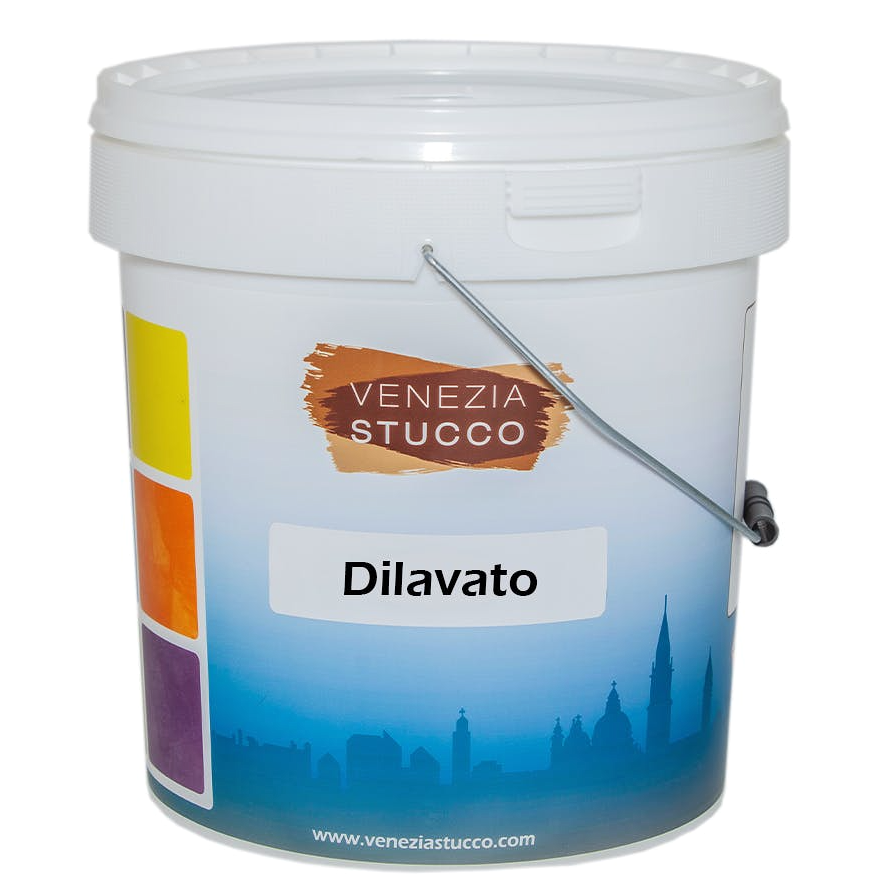Dilavato Plaster for ancient plaster effects
Dilavato Plaster is a lime-based wall stucco plaster. In the manufacturing of our Venezia Stucco materials, we attach great value to the quality of the materials, ease of application and a customized colouring system. The range of additives makes it possible to modify the characteristics of the products and vary the aesthetic effects of our marmorino.

Informations and use of Dilavato Plaster
Dilavato Plaster is a lime-based wall stucco plaster that gives the surface the appearance of an ancient plaster refined by time. The variegated grains of marble that protrude from the opaque surface of the plaster makes this one of the most valuable and evocative stuccos in powder form. It has to be diluted with water to obtain an easy to apply paste. It is available in Fine, Medium and Coarse textures.
Breathable, naturally anti-mould, for indoors and outdoors.
Colour
Ready to use in white, can be coloured with our colour system or customized for any requested colour, while the grains can be customized among the colours existing in nature.
Packaging
- Dilavato Plaster (in powder form) kg 16 bucket
Composition
Lime and grains of precious coloured marbles and special additives (less than 2%)
Application cycle
- Prime with our Quartz Primer or Normal Primer (applied by roller or brush)
- On a completely dry base coat of Dilavato Plaster apply one or two wet-on-wet coats with a sponge.
- When it starts to harden, wipe two to three times with a wet sponge.
Protection
Topcoat with our Waterproofer
RELATED PRODUCTS
Protective and Auxiliary Products
(links to the products)
Quartz Primer -
Primer Normal
[in addition customized marble grains]
Decorative Additives
(links to the products)
Terracotta for Veneziano Medio
Instructions for the application of Dilavato Plaster product
Dilavato Plaster comes in powder form in plastic containers.
If the temperature is too near freezing or too hot, do not apply. If the temperature is high, spray down the wall well with ample amounts of water before starting application. Add enough water so that the plaster is easy to apply (with a little experience you’ll find which works best). The density depends on the personal preference.
The first coat: apply with a metal trowel starting on the upper corner of the wall. The thickness of this coat depends on the size of marble granules, but you should use about 3.5-4 kg per square metre .Each buket should cover 7 sq. meters.
The second coat: once the first is completely dry (also below the surface), the second coat may be applied. If it is necessary you can spray the entire surface uniformly with ample amounts of water.
Apply the second coat like the first, being careful to work seamlessly from one area to the next. Normally, it’s best to have several people working at a time with one person for every 10-15 sq. m. As 1 or 2 people apply the plaster another follows smoothing out the surface with a sponge trowel, wet or dry.
When the application is finished and the plaster has begun to harden, begin the first washing of the surface. Be sure that the surface is hard enough so the plaster won’t be washed away, but before it has begun to dry. Use a medium sized sponge trowel similar in size to the metal one previously used. Wet the sponge trowel well in a bucket of clean water. The idea is to wash off the top film of lime so that the small, colored marble granules are visible.
After washing off the wall leave it alone until the water has disappeared. This usually takes 30 minutes to 3 hours. In cold weather it may be necessary to wait overnight. The final washing should be done by 2 or 3 people always starting in an upper corner of the wall. 1 or 2 people using a large sponge and a bucket of clean water wash the surface until the colored marble granules are visible. The other person follows behind rinsing down the wall. Being careful to wash away all of the lime without leaving drip marks. After two days you can apply waterproofer by brush or spay it
Suggestions for the application of lime plasters like our Dilavato Plaster:
These are suggestions to always keep in mind when applying Marmorino, Intonachino and other lime-based products.
A lime plaster (and also cement) changes color depending on its drying time. However, the general rule of thumb is that the slower it dries, the darker the resulting color. With marmorino, a darker tone is also related to how much pressure is applied during the polishing phase.
It is customary to recommend applying lime plasters at a minimum ambient temperature of 5°C (41°F), but experience has shown that if you want to avoid color differences, the minimum temperature should be higher.
This is also linked to two other factors: the relative humidity of the air which determines drying time and, consequently, the tone of the color, and finally, and just as important, the absorption of the substrate.
Therefore, when applying lime plaster, you have to take into account these three factors.It is difficult to give precise guidelines. It depends a lot on the experience of the technician, who in any case has to keep in mind these factors and understand the characteristics of the materials.
For the substrate: the ideal plaster is one which has the same amount of absorption over its entire surface. If there are areas of concrete under the plaster (for example, around windows or along the area where two floors of a building meet), it’s possible that with a thin layer of plaster, there will be different amounts of absorption. If the temperature and humidity are good enough to ensure a rapid absorption, these differences in absorption rates won’t affect the color. But if there are low temperatures or high humidity, the areas which absorb more slowly will become darker.
It is always recommended to apply primer first. This is not really enough to guarantee an equal absorption rate over the entire area, but is always a good idea. The quality of the primer is especially important when conditions are at a minimum.
Remember that only an experienced technician can guarantee good results. However, if there is one rule, independent of the absorption of the substrate, the humidity should be about 84% and the temperature should not go below 7°C (45°F). Obviously, if the humidity goes up, the temperature should go down.
Always keep in mind that the temperature and humidity should stay within these recommended limits for the entire drying time. The technician could forget that if he finishes applying the material in the afternoon, it could undergo colder temperatures during the night which would push it beyond the recommended limits before drying is complete.
One last thing to remember is that the wind can also play a role and can help to accelerate drying time.
Naturally if the substrate has a uniform absorption and you do all the work on one side of the building on the same day, you can go to the edge of the recommended limits since a small change in color from one side to another won’t be visible.
A brief history of lime as building material
Lime has been used for nearly two thousand years in the construction of foundations, floors and especially in particularly humid environments such as coatings of aqueducts and water pipes. Alongside these structural works it has been used for wall coverings such as mortars, interior and exterior plasters and in various types of decorative applications.
First, a brief mention of lime mortar chemistry, the production of which is basically a three-step process:
- Calcination: When limestone/chalk (calcium carbonate) is burnt in the kiln it turns into quicklime (calcium oxide) and releases carbon dioxide.
- Hydration: Water is added to quicklime/burnt lime to produce hydrated lime (calcium hydroxide). Carbonation: Over the lifetime of lime products, carbon dioxide is gradually re-absorbed by lime from the air, which is also known as “re-carbonation”, as, chemically, this begins to turn the lime back into calcium carbonate, essentially the opposite of the calcining/burning process.
The beginning of the use of
lime in mortars is unclear, however in 4000 BC. the Egyptians discovered that limestone, when burned and combined with water, produced a material that hardened with age. The first documented use of this was when the pyramids were plastered with a lime-based plaster.
An extensive use of
lime mortar occurred when it was adopted by the Greeks and later by the Romans around the first millennium BC. It is not clear when the Romans started using lime mortar, but around 150 BC. it was common practice. The Romans developed a hydraulic-setting lime mortar with the addition of crushed
ceramics,
crushed brick (coccio pesto
in Italy) or volcanic ash (pozzolana -pozzolanic ash) within the mortar mix.
The earliest most important references to lime mortar come from Vitruvius' De Architectura, written around 25 BC.
Vitruvius, specifies a ratio of 1 part lime and 3 parts pozzolan for the lime mortar used in buildings and a 1: 2 ratio of lime and pozzolan for underwater works.
Lime mortar continued to be used from the Roman Empire until about the 19th century, where it was superseded in use by Portland cement mortars.
But, although technology has developed new construction products,
lime mortar is still widely used as a greener construction option than concrete. For both modern and historic homes, it offers a number of advantages that make it highly competitive over alternatives.
Among the most important advantages we have:
-Workability:
Lime mortar has great plasticity. This makes it easy to work with and suitable for modelling in decorative environments.
-Does not separate:
Lime is an excellent
binder. This prevents the mortar from crumbling over time, ensuring its resistance to bad weather.
-Lime is also used to repair traditional buildings that were originally built with lime mortars, this is because lime allows for greater movement without cracking or damaging the original masonry -Lime can also be a great solution to moisture problems as it absorbs water and releases it reducing the chances of water getting trapped and damaging the building.


